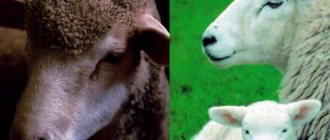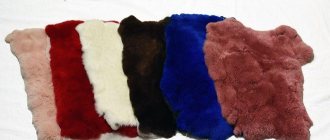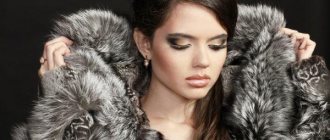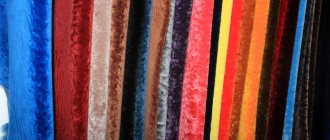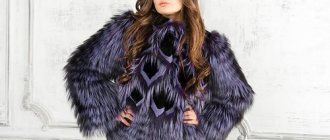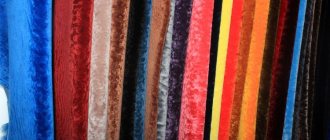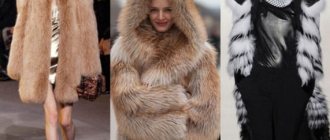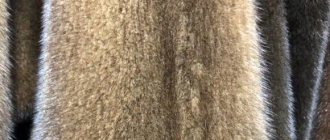Today, more than 600 breeds of sheep are bred all over the world, providing not only meat and wool, but also sheepskin, from which all kinds of outerwear are made. The wide variety of species composition provides the prerequisites for the classification of sheepskins during their processing.
They begin to classify sheepskins (combine them into groups according to certain product characteristics and properties) even at the raw material stage. The division is based on purpose, age of animals and their breed, length and condition of wool, variety and existing defects.
Sheepskins obtained from young animals older than five months and adult animals are divided into three main groups: fur, fur and leather.
Sheepskin outerwear
What is sheepskin?
Sheepskin is the tanned skin of a sheep, taken from adult or young sheep from 6 months of age. The leather processing process takes several days and includes the following steps: pre-treatment, soaking, seeding, seasoning, pickling, tanning, oiling, pressing, drying and polishing. The final stage is stretching the skin, smoothing the edges, combing and finishing the coat.
Leather is classified at the raw material stage. They are grouped according to the following characteristics:
- age of sheep;
- breed;
- number of defects;
- appointment;
- length and quality of wool.
The list of properties affects the cost of the skins or the finished product. Sheepskin has many varieties, the most famous of which are Mouton, Astragan, Tsigeika. Karakul is also sheep fur, but it is the skin of newborn lambs.
Spring types of sheepskin
Separately, fur raw materials of spring species should be considered. It is obtained from the skins of lambs of various breeds, the area of which does not exceed 1800 cm2. The division is based on age and looks like this:
Murakelyam
– skins obtained from miscarriages of coarse-wool sheep, having a moiré pattern and short hair.
Steppe whiting
– skins of lambs of fat-tailed breeds of sheep, having glassy shiny hair and ringed or bean-shaped curls.
Outerwear made of coarse wool sheepskin (murakelam)
Merlushka Russian
– skins of lambs of coarse-haired breeds (not fat-tailed), with loose bean-shaped or pot-shaped curls.
Strap
– skins of lambs of fine-fleece, semi-fine-fleece and coarse-wool breeds, having soft hair and marked ringed or bean-shaped curls.
Sak-sak
– skins of lambs of the dairy period, the hair of which consists of soft braids or loose curls.
Types of sheepskin by fleece type
Depending on the type of fleece, sheepskins are divided into thin, semi-thin and semi-thick. The first type is characterized by thick, uniform hair 6 cm or more in length. Hair tone should be at least 60 (23.1-25.0 microns). Australian Merino sheep are a breed of fine-woven sheep.
Semi-fine wool has a fineness of 50-58 microns (25.1-31 microns). An exception is the fur of the Tsigai sheep, the wool quality of which can be 46 (34.1–37 microns). Hair is distinguished by thickness, elasticity, medium and strong viscosity, and staple structure.
The finely dispersed, coarse-woven variety has heterogeneous suspensions with a staple structure. It contains a large amount of lining fluff and has coarse and long hair on the runway.
Fur sheepskin is worn with the fur on the outside, and fur sheepskin is worn with the fur on the inside. The latter are intended for sheepskin coats, vests and jackets with fur on the reverse side. These types of skins must be endowed with high-quality fur, since it is located on the front side of the product.
Sheepskin jackets are divided into three types: Romanov, Russian and Steppe. Romanov sheepskins are made from Romanov sheepskins and are considered the best. They have a gray-blue color due to the harmonious combination of white fluff and black spiky hair. Russian sheepskin coats are made from raising rough-woven animals, and steppe sheepskins are made from raising rough-woven sheep and Karakul pigs. Steppe and Russian sheepskin skins are divided into white, gray and colored.
There is also sheepskin leather, which has many shortcomings on the fur side. Its quality does not allow it to be used for the same purposes as fur and fur varieties, but it is actively used in the manufacture of shoes, accessories, jackets and leather hats.
Fur sheepskins
Fur sheepskins are obtained from fine-fleece and semi-fine-fleece sheep breeds and hybrids, in which one of the parent forms possessed the necessary characteristics. The qualitative characteristics divide fur sheepskins into fine-fleece, semi-fine-wool and semi-coarse-wool.
Fine-fleece
Fine-wool sheepskin is distinguished by a thick, uniform coat with a hair length of more than 60 mm. Hair, leveled over the entire area of the skin, its fineness should not be less than 60 quality.
Semi-fine fleece
Semi-fine fleece sheepskin has hair with a fineness of 50-58 quality, thick, elastic staple structure, medium or highly crimped. The exception is the sheepskin of the Tsigai breeds, the hair fineness of which is allowed 46 quality.
Semi-coarse-haired
Fur semi-coarse sheepskin allows heterogeneous hair of a staple-braid structure with a high content of fluff and longer guard hair.
Sheepskin fur is used in the same way as any other fur raw material. Products made from them are worn with the fur facing out.
Types of fur by processing method (striga, mouton, tsigeika, etc.)
One of the popular types of sheepskin in Russia is Mouton. The name comes from the French word “mouton”, which means “ram”, “sheepskin coat”. In the production of Mouton products, Australian merino skins are used, but production is carried out only in Russia. This is due to the fact that when processing hides, formaldehyde is used, which is considered harmful.
While the hides are processed, the fur is carefully processed. During tanning, the raw material is treated with a formaldehyde solution, which makes the hair soft and shiny. This treatment makes the fur layer more resistant to mechanical and moisture damage. At the factory, the pile is dyed or dyed. Mouton can be up to 20 different shades, from snow-white to carbon. The most common colors of mouton fur coats are brown and black.
A type of mouton is a fur coat called “astragan”. For its production, special decorating techniques and fur of the highest quality are used. Astragan can be called a fur coat with a tightly twisted curl less than 7 mm long. An astragan coat is lighter than a mouton coat, but at the same time more durable and expensive.
Mouton can be whole (not cut) and shorn. Full Mouton has a pile length of 1-1.2 cm. Coats made from such furs can be worn at temperatures down to -35 °C. Cropped hair has a fluff of 0.6-0.8 cm and is able to retain heat in winter at temperatures not lower than -15 ° C. Astragan is distinguished by the fact that it has thin fur, 0.2 to 0.7 cm long, that can withstand temperatures not lower than -10 ° C.
Tsigeika is a short-haired sheepskin coat. Currently, this type of fur has been practically replaced by mouton. Tsigeika was popular in the USSR; it was made using the same technology as mouton, but the pile was thicker. Some modern designers use this material to sew fashionable clothes.
Sheep's wool coat - what is it?
Winter, coming into its own, will immediately call on all fashionistas and fashionistas to warm themselves up. Having inhaled the fresh smell of the first frost, feeling the harsh breath of the northern wind, those who were late will rush to buy warmer clothes.
Then every chilled girl and woman will have a question: “ How to dress stylishly, beautifully, comfortably and, most importantly, warmly?” What's fashionable this season? And although tired down jackets, warm coats, natural mink, wolf, fox or arctic fox fur coats have been waiting for a long time at home, I still want something new, more modern, light and comfortable.
And the alternative, here it is - very close! Many fashionistas are already pleased with sheep wool coats - the trend of the season and, at the same time, the lives of animals saved. Winter clothes made from natural sheared sheep fur will warm their owners in any frost from -1°C to -25°C.
Many contemporaries have already abandoned outerwear made of natural fur (heavy, hot and uncomfortable). Lightness, warmth and comfort were chosen by famous artists, politicians, writers, artists, popular couturiers, stylists and many other people who prefer not only comfort, but also humane treatment of animals.
Look at the world with different eyes and make the right choice, saving the lives of thousands of innocent people, our least friends. Let eco-friendly sheep wool coats please and warm you this winter!
Is it possible to freeze in winter wearing a sheepskin coat?
Cute, hardworking sheep spend the whole summer growing thick, warm fleece, and in the spring, after being sheared, they donate their valuable, luxurious fur to people. Special machines apply ready-made wool, which has gone through all stages of processing and dyeing, onto a base of textile or knitwear and obtain a modern, soft, hygroscopic and warm material. Every stylish girl or lady will have the opportunity to flaunt a soft and light fur coat without harming a single sheep and, at the same time, promoting the animal protection movement.
Modern, warm and stylish eco-fur will completely replace natural cured sheep skin - a “cruel” type of beauty. Your new trendy sheepskin coat will not allow you to freeze, because it:
- insulated with an internal felt ball formed during knitting;
- has thermoregulation functions and “breathes” without creating a greenhouse effect. Therefore, you will never overheat or overcool;
- Sheep's wool, due to its sinuous fiber structure, traps air between the fibers. The fur coat works according to the “climate control” type, providing a comfortable existence for its owner.
Such clothes can be worn even in the harsh conditions of Yakutia or Siberia with temperatures down to 25°C.
How to distinguish different types of fur from each other when choosing a product?
When choosing a sheepskin coat or vest, pay attention to the length of the fur, its appearance and tactile properties. Products made from mouton are the warmest, the fur on them does not have curls, and at the same time they are quite heavy. Astragan is soft to the touch and its hair is shorter and has distinct curls. Tsigeika is warm, heavy and rough to the touch.
A little history
The fashion for sheepskin coats, which, however, as in any other city in Russia, anyone can buy in Moscow if they are financially able, came to Europe from Russia. Several decades ago, the eminent couturier Vyacheslav Zaitsev presented a magnificent collection on the high fashion catwalk, which included premium sheepskin fur coats. It created a real sensation in the minds of sophisticated Europeans, and after some time, products made from this material began to appear in the collections of other designers. Among them were such giants of the fashion industry as Burberry, Just Cavalli, Marc Jacobs, Max Mara, H&M, Oasis, New Look, Zara and Chanel.
Recommendations for caring for different types of sheepskin products
With proper care, a sheepskin coat will last up to 6 seasons. The coat label contains information on how to care for it. Products made from such fur should be protected from exposure to chemicals, including hairspray, deodorants and antistatic agents. Fur coats should not be placed next to heating devices. Hair should be stored in a fabric cover over the padded shoulders.
If there is a stain on the astragan, it can be removed with ammonia and salt. The ingredients are mixed in a 3:1 ratio and applied to the stain with a brush. After removing the stain, moisten the wool with clean water and dry in a well-ventilated place. If it is not too dirty, you can simply sprinkle the stain with salt and comb it out with a comb. In the same way, you can clean Romanov, steppe, thick-wool and other types of sheep fur.
Such different sheepskin coats
On the World Wide Web you can find both positive and negative reviews about sheepskin coats. It all depends on the manufacturer, or more precisely, on the quality of the products that he offers. In addition, there are different types of sheepskin. Depending on the breed and age of the sheep, furs may look different and have different performance properties. Astragan, mouton and astrakhan fur are produced from natural sheepskin. By the way, one of the main factors determining the price of a sheepskin coat is the type of fur from which it is made.
Mouton, astragan and astrakhan fur coats share one important quality - the ability to perfectly retain heat. That is why they are an ideal option for the frosty Siberian winter. The exception is lighter fur coats made from sheared sheepskin, which performed well in less severe temperature conditions.
